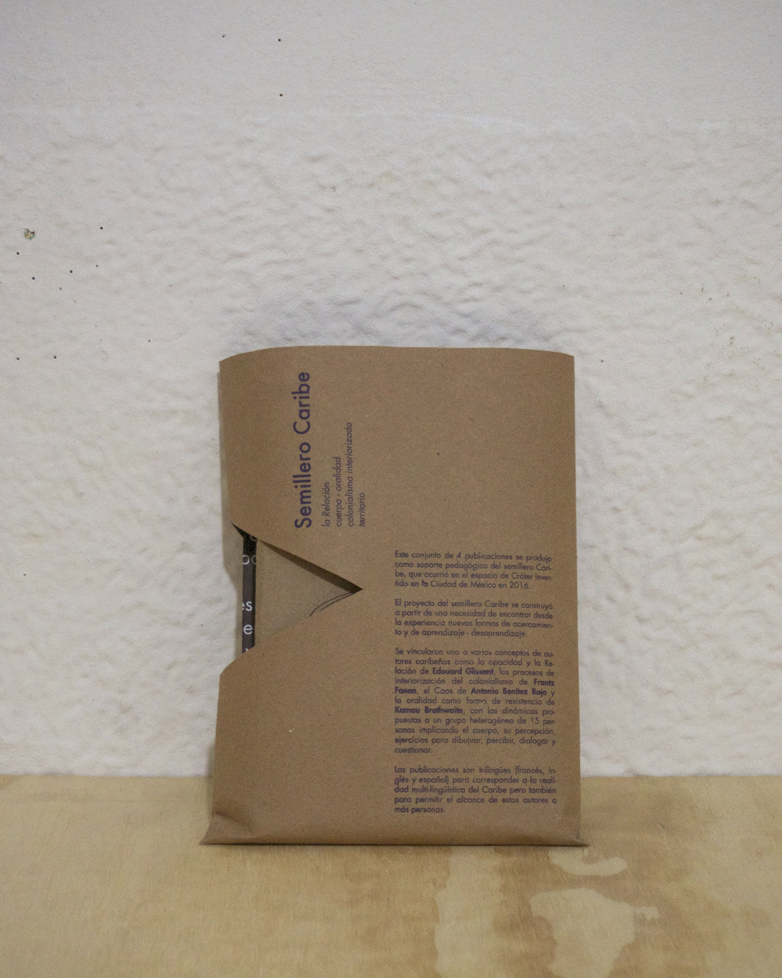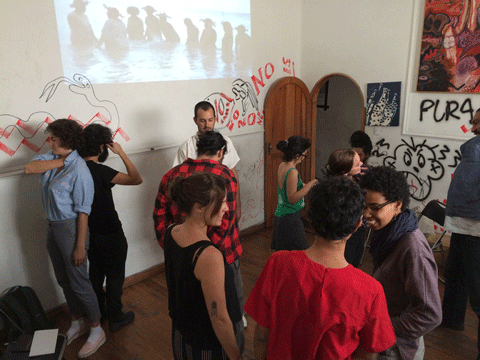

The project of Semillero Caribe was realized thanks to the collaboration of visual artists Madeline Jimenez (Dominican Republic), Ulrik López (Puerto Rico) and Minia Biabiany (Guadalupe), from a necessity to find from experiences some new forms of learning and approaching non-european theories. This is part of the program “Seminaries in the present” by the Cooperative Crater Invertido with the help of Arts Collaboratory.
This group of 4 publications were produced as a pedagogical support for the Semillero Caribe, which occurred in Mexico City at Crater Invertido during 4 weeks between February and March of 2016. A group of 15 heterogeneous participants worked on a series of dynamics that implied the use of the body and it’s perception, drawing, dialogs and questioning. The Semillero Caribe happened in 8 sessions of 3 hours, each one linked to one or more concepts by caribbean authors for example the opacity and the Relation by Edouard Glissant, the process of internalized colonialism of Frantz Fanon, the Chaos of Antonio Benítez Rojo and orality as a form of resistance by Kamau Brathwaite.
This group of 4 publications were produced as a pedagogical support for the Semillero Caribe, which occurred in Mexico City at Crater Invertido during 4 weeks between February and March of 2016. A group of 15 heterogeneous participants worked on a series of dynamics that implied the use of the body and it’s perception, drawing, dialogs and questioning. The Semillero Caribe happened in 8 sessions of 3 hours, each one linked to one or more concepts by caribbean authors for example the opacity and the Relation by Edouard Glissant, the process of internalized colonialism of Frantz Fanon, the Chaos of Antonio Benítez Rojo and orality as a form of resistance by Kamau Brathwaite.
The selection of texts for each publication made the groundwork for each of the axis: The Relation, body/orality, internalized colonialism and territory. The publications are tree-lingual (french, english and spanish) to correspond to the multi-lingual reality of the Caribbean, and also to expand the reach of these authors to a broader public (most text existed in one or two languages, just with the exception of Fanon’s texts).
The Caribbean was the entrance door of the European invasion of “America” and from that moment, a laboratory of human hierarchical relationships, from slavery, going through colonialism, and arriving at modern capitalism. From that diversity created by its history (different colonizers, languages and political systems) and its geography (archipelagoes, different climates and dimensions of territories) the Caribbean generated forms of resistance and sometimes resilience, with a certain understanding of the body.



El proyecto de Semillero Caribe se construyó gracias a la colaboración de las artistas visuales Madeline Jiménez (República Dominicana), Ulrik López (Puerto Rico) y Minia Biabiany (Guadalupe), por la necesidad de encontrar a partir de experiencias nuevas formas de aprendizaje y acercarse a lo no teorías europeas. Esto es parte del programa "Seminarios en el presente" de la Cooperativa Crater Invertido con la ayuda de Arts Collaboratory.
Este grupo de 4 publicaciones fue producido como un apoyo pedagógico para el Semillero Caribe, que ocurrió en la Ciudad de México en Crater Invertido durante 4 semanas entre febrero y marzo de 2016. Un grupo de 15 participantes heterogéneos trabajó en una serie de dinámicas que implicaban el uso del cuerpo y su percepción, dibujo, diálogos y preguntas.
El Semillero Caribe sucedió en 8 sesiones de 3 horas, cada una ligada a uno o más conceptos por autores caribeños por ejemplo la opacidad y la Relación de Edouard Glissant, el proceso de colonialismo internalizado de Frantz Fanon, el Caos de Antonio Benítez Rojo y la oralidad como una forma de resistencia por Kamau Brathwaite. La selección de textos para cada publicación formó la base para cada uno de los ejes: la relación, el cuerpo / la oralidad, el colonialismo internalizado y el territorio. Las publicaciones son multi-lingual (francés, inglés y español) para corresponder a la realidad multilingüe del Caribe, y también para expandir el alcance de estos autores a un público más amplio (la mayoría del texto existía en uno o dos idiomas, sólo con la excepción de los textos de Fanon).
El Caribe fue la puerta de entrada de la invasión europea de "América" y desde ese momento, un laboratorio de relaciones jerárquicas humanas, desde la esclavitud, pasando por el colonialismo y llegando al capitalismo moderno. A partir de esa diversidad creada por su historia (diferentes colonizadores, idiomas y sistemas políticos) y su geografía (archipiélagos, diferentes climas y dimensiones de territorios), el Caribe generó formas de resistencia y en ocasiones resiliencia, con una cierta comprensión del cuerpo.


